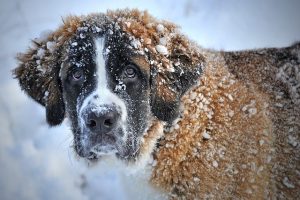 After a shoot day, it is imperative to ensure your dog goes to bed well-fed, warm and thoroughly dried. Although it is unusual to witness dogs with hypothermia in the mild winters of late, a dog left wet, and already tired after a hard day’s work, is especially vulnerable to it.
After a shoot day, it is imperative to ensure your dog goes to bed well-fed, warm and thoroughly dried. Although it is unusual to witness dogs with hypothermia in the mild winters of late, a dog left wet, and already tired after a hard day’s work, is especially vulnerable to it.
Using a heat lamp to dry off after a day’s shooting ensures your dog goes to bed properly dried off and warm. If your dogs live outside during the winter, raise their house off the floor at least four inches, make sure it has a sloped roof and is well insulated. If they live in an outhouse or barn, provide closed-in beds with warm and dry bedding.
Recognising the signs
Identified as intense shivering; the onset of hypothermia will slow your dog right down. With this reluctance to keep moving comes more significant danger of deterioration. Muscular stiffness and a visibly escalating lack of co-ordination will follow. Left untreated, the dog’s heart and breathing rates will decrease, the pupils will dilate, and it will collapse into a coma.
As hypothermia is an emergency, you should call your vet immediately.
What to do if you think your dog has hypothermia
A rapid response could save your pet’s life. It’s essential to call your vet immediately and follow their instruction.
In the meantime, you can do the following;
- Do not place your pet anywhere hot. Warming them up too suddenly can send them into shock. Get them out of the cold, to somewhere warm and sheltered. Warm them up gradually with thick blankets, under and around them.
- If your dog is wet, dry them gently with a towel. If the dog is conscious, try and encourage a drink of lukewarm water.
- Regardless of your opinion regarding the severity of the situation, get your dog to the vet for assessment.
Dogs more susceptible to hypothermia
It’s essential to recognise that some dogs are much more vulnerable to the cold than others. These include dogs that live outside for long periods with inadequate shelter and space to run around, wet dogs, puppies, dogs with diabetes, smaller breeds, and shorthaired dogs.


